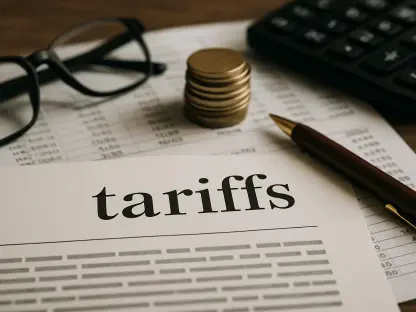In the intricate realm of equity derivatives, traders find themselves assessing the tides shaped by global economic indicators and geopolitical shifts. Amidst this dynamic environment, the S&P/ASX 200 and KOSPI 200 indices serve as pivotal markers of market trends. These indices, reflecting the pulse of major economies like Australia and South Korea, face fluctuating trajectories due to a blend of corporate actions, investor sentiments, and intercontinental policies. Central to this discourse is the pivotal role of geopolitical tensions and their profound impact on market volatility, particularly in light of anticipated tariff modifications by the United States. As traders navigate these waters, they must contend with elevated options activity and volatility that underscore the profound influence of policy shifts on investor decisions and market momentum.
Market Dynamics and Economic Indicators
Influence on S&P/ASX 200 Index
The S&P/ASX 200 index’s future trajectory remains tangled in the web of Australia’s global trading alliances and regional economic fluctuations. The complex interplay between domestic growth and external pressures from international partners enhances the equation of market volatility. Australia’s economic canvas is deeply colored by its trading relationships, especially those with Asia, where altering U.S. tariff policies loom with potential repercussions. These hints of international policy recalibration may exert pressure on the regional economies, causing unpredictable shifts in equity markets. Established economic indicators, such as employment rates and inflation trends, further complicate the scenario by altering corporate profitability and stock valuations. Consequently, strategic trading and investment approaches necessitate a comprehensive understanding of the symbiotic relationship between geopolitical shifts, economic data, and regional market dynamics.
Navigating KOSPI 200 Challenges under U.S. Policy Revisions
The KOSPI 200 stands as a sentinel guarding the economic interests of South Korea amidst the shifting sands of global market interactions. U.S. tariff changes introduce layers of uncertainty for the South Korean economy, affecting its export-driven growth. Despite the absence of immediate interest rate alterations from South Korea’s central banks, financial experts anticipate significant changes in economic conditions. In this complex landscape, strategic investments must consider not only the monetary policies but also broader economic indicators like the balance of trade and consumer spending trends. An in-depth examination of the KOSPI 200 index reveals the intricate balance required between investor expectations, trade dynamics, and national policy responses. The careful assessment of these multifaceted aspects empowers traders with tactical strategies essential for managing market volatility and optimizing investment returns.
Corporate Actions and Investor Sentiments
Samsung Electronics and Share Buyback Implications
Samsung Electronics’ decision to initiate a substantial share buyback plan has been a major talking point across global markets, triggering varied investor responses. This corporate action aligns with a broader trend among large entities aiming to reinforce stock value through buybacks. Such maneuvers serve dual purposes: they signal confidence in future earnings and stabilize stock prices by reducing public float. Samsung’s strategic move catalyzed heightened trading activity reflecting mixed sentiments from traders who continuously recalibrate their positions based on the latest developments. This volatility echoes an intrinsic characteristic of markets where corporate decisions intersect with investor expectations to create dynamic trading environments. By understanding the micro and macroeconomic factors underpinning such initiatives, investors can better align their portfolios with evolving market conditions, seizing opportunities while mitigating the risks of abrupt fluctuations.
Elevated Volatility and Central Bank Decisions
Volatility, particularly in equity derivatives markets, remains elevated, influenced largely by looming central bank decisions. As the Bank of Korea approaches critical interest rate adjustments, options pricing anticipates resultant market reactions. Elevated volatility signals uncertainty and can be both an opportunity and risk, pushing options activity to new heights. Investors keen on capitalizing on these fluctuations must stay attuned to evolving central bank policies, economic data releases, and geopolitical developments. Effective risk management strategies become imperative as traders balance the prospects of potential gains with the dangers posed by sudden market movements. Adopting tactical approaches rooted in comprehensive market evaluations allows investors to navigate this volatility, leveraging foresight in policy analysis to enhance their market position while safeguarding against unpredictable shifts.
Shifting Trends in Global Market Strategies
Hong Kong Financials and Options Activity
Hong Kong’s financial markets exhibit increased options activity, suggesting a shift in market sentiment amid evolving geopolitical and economic factors. This shift underscores the broader trend observed across different regions, where structural changes in policy, trade partnerships, and regulatory environments necessitate strategic adjustments. Investors in Hong Kong are especially sensitive to geopolitical developments in nearby regions that affect financial health and exchange rates. Such interconnectedness requires a sophisticated understanding of local market dynamics combined with global perspectives. Options markets, often viewed as barometers of future market expectations, provide valuable insights into investor sentiment shifts and anticipated economic trends. By analyzing shifting options activity, traders possess the strategic advantage of predicting forthcoming market movements and adjusting investment strategies accordingly.
Interplay of Geopolitical Events and Market Reactions
Geopolitical developments intricately influence global equity markets, as countries reassess foreign policies and international trade agreements. These changes lead to new alliances and conflicts, impacting investor confidence and economic forecasts, requiring detailed analysis for traders looking to optimize their positions. Modern economies are deeply interconnected, meaning geopolitical actions have wide-reaching effects beyond their origin. Traders face challenges due to unstable policies and swift changes in economic indicators. A deep understanding of geopolitical narratives helps investors navigate market volatility, utilizing insights to adapt investment strategies. This balanced approach allows market players to capitalize on opportunities while considering potential risks.
Navigating market volatility amid geopolitical and policy factors demands a robust strategy. Investors need to understand the impact of U.S. tariffs and central bank policies on indices like the S&P/ASX 200 and KOSPI 200. Corporate moves, such as Samsung’s share buyback, significantly influence volatile markets. Hong Kong financials showed local and global sentiment shifts, altering market dynamics and options activity. Adapting to trends through understanding geopolitical events and economic indicators is essential, underscoring the importance of a balanced trading strategy to manage risks and seize opportunities in this dynamic landscape.









